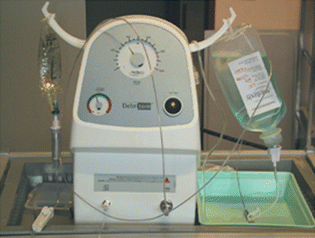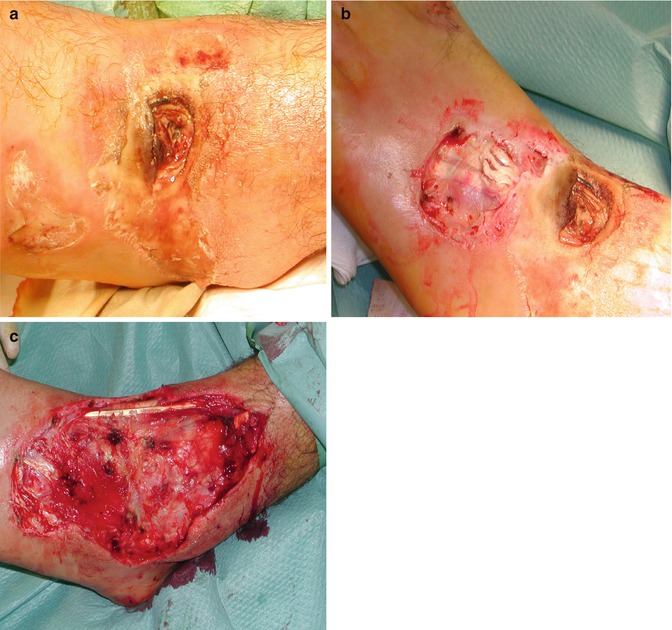Fig. 45.1
Leg and abdominal involvement with ulceration and livedoid aspect
In pressure ulcers the necrotic block offers simpler debridement strategies than when necrosis is spread all over the wound surface in an uneven manner.
45.2 Description of Recently Developed Debridement Technologies
Blades and scissors were used by generations of surgeons, debridement being quickly and safely obtained within a short period of time. This technique used in trauma wounds is well defined, and, apart from necrosis, sloughy and fibrinous tissues should be removed, in order to minimise devascularisation of the surrounding tissues.

1.
JACΤΜ (Medaxis) [3]
The system of wound rinsing uses a waterjet with a pressure reaching 20 bars adjustable with a control valve.
The system is filled with a 500 ml saline put under pressure, thanks to a gas cartouche. A protective film is placed around the wound and a single-use handpiece is connected to the system. Its use is recommended over the acute and chronic wounds. The JAC technique allows to reduce the bacterial burden and local infection, to reduce odour of malodorous wounds and to access difficult-to-reach areas and to stimulate the wound bed.
2.
DebritomΤΜ (Medaxis) (Fig. 45.2)
Microjet high-pressure technology (from 0 to 1,000 bars) for cleansing and debriding wounds.
Stationary and mobile use composed of a liquid pump aspirating the sterile water (NaCl 0.9 %) and drives it through a metallic high-pressure tube to a handpiece (foot pedal command).
The liquid is expulsed by the hose from the handpiece (single use). Protective tents are needed in order to protect the practitioner and the surrounding from any projections coming from the wound. The jet allows to clean, cut and debride with an adaptable pressure and stimulates the wound by microbleeding mechanical stimulation.

Fig. 45.2
DebritomTM: the compressor is connected to a hand piece projecting high speed water jet over the wound
The Debritom offers a high-power jet but needs protection to prevent projections.

3.
VersajetΤΜ (Smith & Nephew)
High-pressure hydrosurgery system of lavage by impulsions incrementing the debriding effect combined to an aspiration system linked to the Venturi effect, may reach 850 bars [4].
Stationary and mobile use, the system includes an electrical power pad (pedal commanded) with a connection for saline perfusion and a single-use hose for saline perfusion connected to a trash collector to aspirate the debrided tissues [5, 6].
Allows to undermine, cut and excise, thanks to the high-speed liquid flow at the window level, with three different sizes (15°, 14 mm; 45°, 14 mm; 45°, 8 mm) (Fig. 45.3a, b, c).

Fig. 45.3
(a) Electrical burns of the dorsal aspect of the foot. Extension of post burns necrotic tissue is hard to underline. (b) Starting debridement using VersajetTM exposes necrotic tendons. (c) VersajetTM has debrided step by step all devascularised structures, leaving the wound prepared for a skin graft
(a) Electrical burns: the extent in depth cannot be determined precisely.
(b) Using Versajet, hypodense necrotic structures will be destroyed and removed.
(c) Debridement completed: all remaining structures are living and ready to be covered using skin grafting.
Get Clinical Tree app for offline access

4.
WoundWandΤΜ (ArthroCare)
Electrochemically induced plasma creating an instant necrosis of tissues around the electrodes, with reduced thermal damages (45° max).
Stationary use, the system includes a CCD machine to create electrochemical signals, with a connection to saline perfusion and a single-use hose for saline perfusion connected to a trash collector to aspirate the debrided tissues.
Stay updated, free articles. Join our Telegram channel

Full access? Get Clinical Tree








